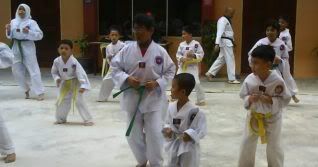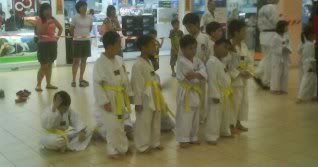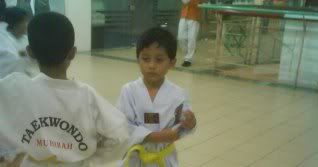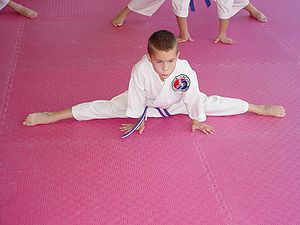The kicks used in Taekwondo sparring are more striking than in any other martial art. Even though the kicks in poomse are simpler than the ones used in sparring, they can be equally as impressive if executed properly.
Also, a good, solid front kick is more impressive than an impromptu tornado or double roundhouse kick.
What is it that makes a great taekwondo kick?
 Image via Wikipedia
Image via Wikipedia1. Balance
Balance may not be seem as obvious as you think. And balance is more than just not ending up on the floor. It is a matter of fluidity, of gracefulness, of naturalness.
With a properly balanced kick, the supporting foot does not wobble, the hands do not flail about, and the athlete does not rush to complete the kick.
Also, the athlete begins and ends the technique in the proper stances without having to correct the stances to accommodate the kick.
Practice moving within your stances. When you feel comfortable doing simple things within your stances, you should try to kick from one stance into another.
2. Proper form
Having proper form is a requirement to having a beautiful kick. Proper form may be defined as the correct positions to which the entire body enters as it performs a kick from start to finish.
It is wise to talk with your instructor or other certified professional martial artist to learn the more articulate details of proper form. They will have the answers to any questions that you may have.
3. Control
The kick in Taekwondo is not supposed to be like that of a whip. It does not have to be so fast that it cannot be seen.
Instead, the kick is to be relished and beheld as the single most attractive feature of Taekwondo.
It is therefore necessary to control the kick. Controlling the kick involves the ability to freeze the kick for a split second at full extension.
This “freeze” is the life of the kick. It is the most memorable and beautiful part of the kick. Controlling the kick is not that easy though. Usually it involves much concentration and many years of practice.
Form is a must to both control and power. If you are not sure that you are doing the kick with proper form yet, keep working on the form part before you begin working on the control part.
Control takes some muscle development and patience, but it is well worth all the effort in the end.
4. Power
Nothing is worse than seeing someone perform a kick with great form, balance, and control, but with no power.
If this is the case, that person is better off as ballet dancer than a taekwondo practitioner. There is no such thing as an excellent kick that has no power.
Take note that proper form is needed to achieve control. And control is the factor that leads to power.
Bear in mind also that if you try to develop power without mastering the proper control first, it may result to permanent damage to your joints. So be very careful.
The process for developing power in a taekwondo kick is very similar to developing control in that same kick.
Note : Taekwondo is not Taekwondo without The Taekwondo Kid :-)














